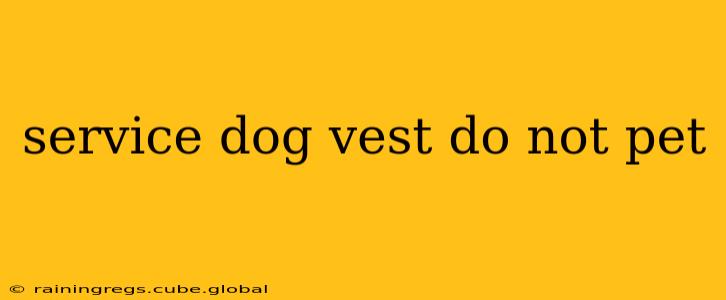Service dogs are highly trained working animals providing invaluable support to individuals with disabilities. Their vests, often emblazoned with the phrase "Do Not Pet," serve a vital purpose beyond simple identification. Understanding why this message is so crucial is essential for responsible interaction and ensuring the continued effectiveness of these life-changing partnerships.
What Does a Service Dog Vest Mean?
A service dog vest, often brightly colored, clearly indicates that the dog is working. The vest's primary function is to signal to the public that the animal is not a pet and should not be approached or distracted. While some vests may simply display an identifying patch, many incorporate the clear and concise message: "Do Not Pet." This instantly communicates a crucial boundary for respectful interaction.
Why Should You Not Pet a Service Dog?
Ignoring the "Do Not Pet" message can have serious consequences, impacting both the handler and the service dog. Here's why:
Distracting the Dog from its Work
Service dogs are highly focused on their tasks. Even seemingly harmless interactions like petting can disrupt their concentration, leading to a missed critical alert or an inability to perform their assigned duties. This disruption could have significant consequences for the handler's safety and well-being. Imagine a service dog trained to detect seizures—a distraction could mean the handler doesn't receive timely assistance.
Potential for Injury
Service dogs are trained to maintain focus, even in distracting environments. Unexpected petting or attention can trigger reactions, resulting in the dog potentially snapping, biting, or otherwise causing unintentional injury. This is not a reflection of the dog's temperament, but rather a defensive response to unwanted interference during work.
Health Concerns
Service dogs, like any animal, can carry bacteria or other germs. While generally healthy, interacting with them without the handler's consent presents a potential health risk. The handler, especially individuals with compromised immune systems, may be particularly vulnerable.
Legal Ramifications
In many jurisdictions, interfering with a service dog is against the law. While the specifics vary, generally, obstructing a service animal from performing its duties or repeatedly ignoring clear "Do Not Pet" signage can lead to fines or other legal repercussions.
What to Do if You See a Service Dog
When you encounter a service dog and its handler, the best approach is to simply give them space and respect their privacy. Do not attempt to pet the dog, talk to it, or engage with it in any way. If you have a question, you can politely address it to the handler after ensuring you’re not interfering with their tasks. Remember, the handler is relying on their service dog's focus and undivided attention for their safety and independence.
What if a Dog Doesn't Have a Vest?
While vests are common, not all service dogs wear them. If you're unsure whether a dog is a service dog, it's best to err on the side of caution and avoid interaction. Only trained professionals can assess if a dog is performing working duties.
What are the Different Types of Service Dog Vests?
Service dog vests vary widely in appearance, from simple, functional designs to more elaborate styles. Some vests feature specific branding of service dog training organizations, indicating the dog's professional credentials. The message itself might also vary—some use phrases like "Working Dog," "Service Animal," or even the dog's name and handler's information. However, the overarching purpose remains consistent—to communicate that this is a working animal that requires respectful distance and should not be distracted.
Can I Approach a Service Dog Handler for Information?
It’s acceptable to politely approach the handler after ensuring you're not interfering with them. However, avoid questions about the nature of the disability or the dog's specific training. These are private matters.
By understanding the vital role of "Do Not Pet" on a service dog's vest and respecting the working animal's space, we contribute to a more inclusive and supportive environment for people with disabilities.
